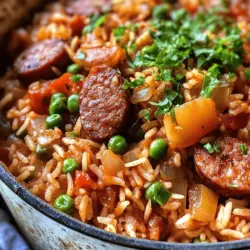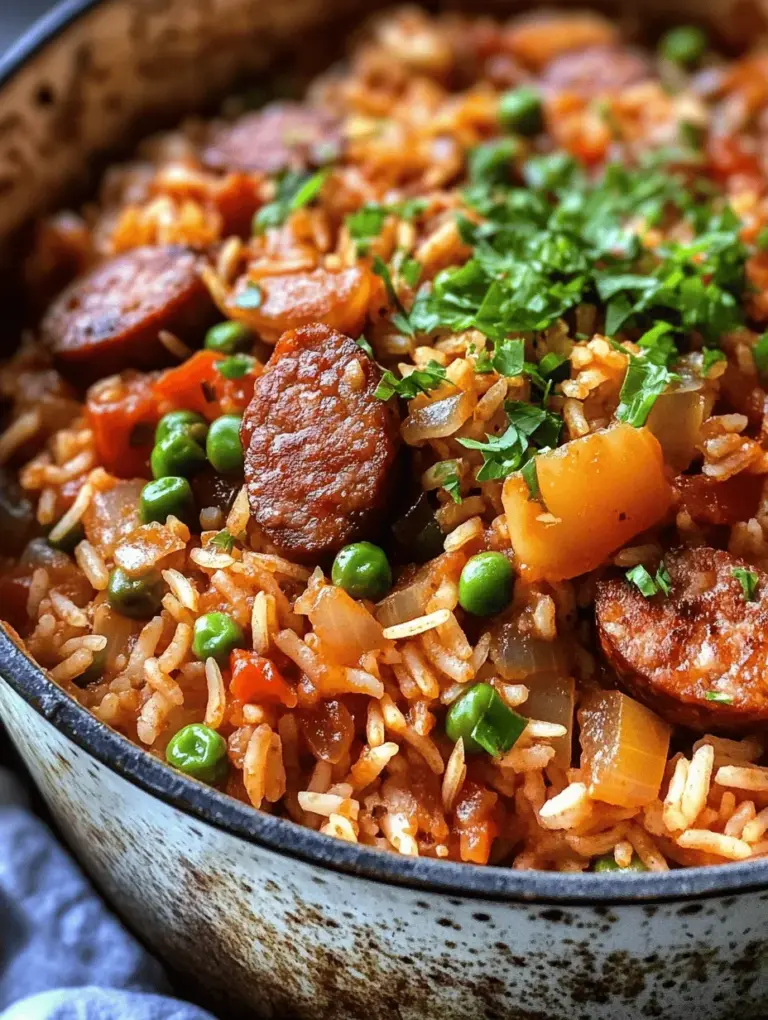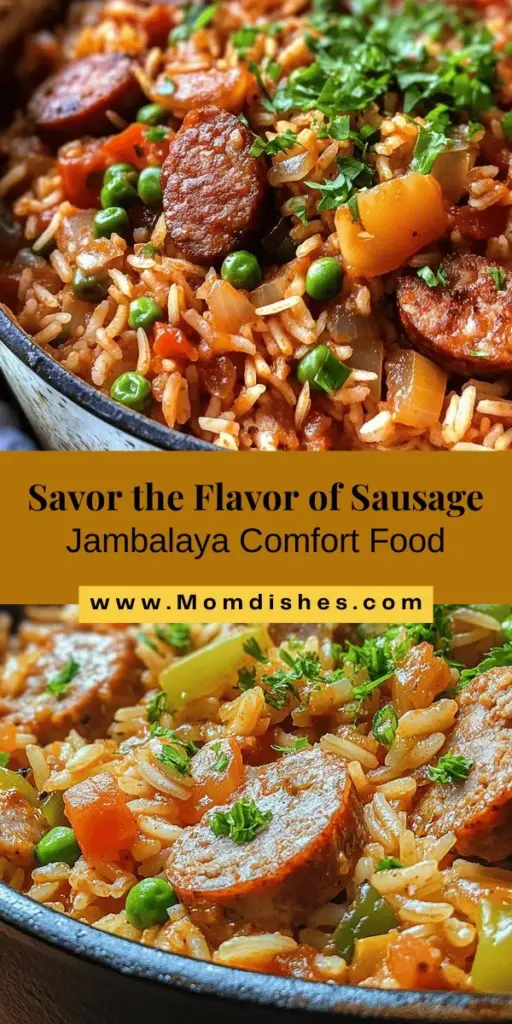Introduction
Creole cuisine is a vibrant tapestry of flavors, colors, and textures that reflects the rich cultural history of Southern Louisiana. Known for its hearty and comforting nature, dishes like sausage jambalaya stand out as quintessential representations of this culinary tradition. Jambalaya, with its warm, aromatic essence, is not just a meal; it’s a celebration of community and family. This dish embodies the spirit of Creole cooking, where ingredients come together in a harmonious blend to create something truly special.
The origins of jambalaya can be traced back to the 18th century in Louisiana, where it emerged as a delightful fusion of Spanish paella and French influences mixed with local ingredients. This dish quickly became a beloved staple for gatherings, family dinners, and festive occasions, thanks in part to its ability to feed a crowd with ease. The beauty of jambalaya lies in its versatility; it can be made with a variety of proteins and vegetables, but one version that consistently shines is the sausage jambalaya. This recipe combines the irresistible flavors of andouille sausage with a medley of vegetables and spices, creating a dish that is as satisfying as it is delicious.
In this article, we will delve into the delightful world of sausage jambalaya, exploring its rich history, key ingredients, and a step-by-step guide to crafting this comforting dish. So roll up your sleeves and prepare to infuse your kitchen with the heartwarming aromas of Creole cuisine.
Understanding Jambalaya: A Creole Classic
To truly appreciate sausage jambalaya, it’s essential to understand the dish’s historical and cultural context within Creole cuisine. Jambalaya is believed to have evolved from the Spanish influence in Louisiana, particularly with the introduction of rice as a staple ingredient. The dish’s name is derived from the Spanish word “jamon,” meaning ham, which hints at the early versions of jambalaya that featured cured meats. Over time, this dish absorbed influences from various cultural groups, including African, French, and Spanish, resulting in the vibrant and complex flavors we recognize today.
The evolution of jambalaya can be categorized into two primary styles: Creole and Cajun. Creole jambalaya, often referred to as “red jambalaya,” includes tomatoes and a variety of meats, while Cajun jambalaya, or “brown jambalaya,” usually omits tomatoes and relies on a darker, richer flavor profile. Sausage jambalaya represents the Creole style, where the addition of flavorful andouille sausage enhances the overall taste and texture of the dish. This rich culinary legacy makes jambalaya not only a cherished meal but also a symbol of the diverse cultural heritage of Louisiana.
In the context of Southern cooking, jambalaya is more than just a dish; it is an expression of community and togetherness. Whether served at a lively family gathering or a festive celebration, this dish brings people together, encouraging shared conversations and laughter over a hearty meal. The comforting nature of sausage jambalaya makes it an ideal choice for any occasion, leaving a lasting impression on all who partake in its deliciousness.
Ingredients Breakdown
Creating a delicious sausage jambalaya requires a careful selection of ingredients, each contributing to the dish’s overall flavor and texture. Let’s take a closer look at the key components that make this recipe a standout.
Andouille Sausage
At the heart of sausage jambalaya is the iconic andouille sausage. This smoked sausage, traditionally made from pork, is known for its robust flavor and spicy kick. Its smoky notes and complex seasoning make it a staple in Creole cooking, providing depth and character to the dish. The use of andouille sausage not only enhances the overall taste but also pays homage to the culinary traditions of Louisiana, where this sausage is a beloved ingredient in many classic dishes.
Vegetables
The foundation of flavor in sausage jambalaya is built upon a classic combination of mirepoix, which consists of onion, bell pepper, celery, and garlic. These aromatic vegetables form the base of the dish, infusing it with sweetness and depth. The onion provides a rich, savory flavor, while the bell pepper adds a touch of sweetness and color. Celery contributes a subtle earthiness, and garlic brings a savory punch. Together, these vegetables create a flavor profile that is essential to any great jambalaya.
Rice and Broth
Long-grain white rice is the ideal choice for jambalaya, as its fluffy texture allows it to absorb the flavors of the broth without becoming mushy. The rice serves as the canvas for the dish, soaking up the spices and juices from the sausage and vegetables. Chicken broth is typically used to cook the rice, infusing it with additional flavor and richness. The careful balance of rice and broth is crucial, as it determines the overall texture and taste of the jambalaya.
Spices
The signature taste of sausage jambalaya comes from a carefully curated blend of spices. Cajun seasoning is a must-have, bringing together a medley of paprika, cayenne pepper, garlic powder, and onion powder. This seasoning mix adds warmth and depth to the dish, giving it that distinct Creole flair. Smoked paprika, in particular, imparts a rich, smoky flavor that complements the andouille sausage beautifully. A touch of cayenne pepper adds a spicy kick, allowing diners to adjust the heat level to their preference.
Additions
To elevate your sausage jambalaya further, consider adding frozen peas during the last few minutes of cooking. The peas provide a pop of color and sweetness, creating a delightful contrast to the savory elements of the dish. For garnishing, chopped green onions and fresh parsley add a refreshing burst of flavor and a hint of brightness, making the jambalaya visually appealing and even more delicious.
Preparation Steps for Sausage Jambalaya Delight
Now that we’ve explored the rich history and essential ingredients of sausage jambalaya, it’s time to dive into the preparation process. Crafting this Creole delight is straightforward, and with a few simple steps, you can create a dish that will impress your family and friends.
Preparation
1. Browning the Sausage: Start by slicing the andouille sausage into bite-sized pieces. In a large, heavy-bottomed pot or Dutch oven, heat a tablespoon of oil over medium-high heat. Once hot, add the sausage and cook until browned and slightly crispy, about 5-7 minutes. This step is crucial, as browning the sausage develops a rich, savory flavor that will permeate the entire dish.
2. Sautéing the Vegetables: After the sausage is browned, remove it from the pot and set it aside. In the same pot, add the diced onion, bell pepper, celery, and minced garlic. Sauté the vegetables over medium heat for about 5-6 minutes, or until they are softened and fragrant. The fond that forms on the bottom of the pot from the sausage will add a depth of flavor to the vegetables.
3. Combining Ingredients: Once the vegetables are tender, return the browned sausage to the pot. Stir in the long-grain rice, allowing it to toast slightly in the mixture for about 2 minutes. This step enhances the rice’s flavor and prepares it for absorbing the broth.
4. Adding the Broth and Spices: Pour in the chicken broth, ensuring that the rice is fully submerged. Add the Cajun seasoning, smoked paprika, cayenne pepper, and a pinch of salt and pepper to taste. Stir everything together, bringing it to a gentle boil.
5. Simmering: Once boiling, reduce the heat to low and cover the pot. Allow the jambalaya to simmer for about 20-25 minutes, or until the rice is tender and has absorbed most of the liquid. Avoid lifting the lid too often, as this can disrupt the cooking process and release steam.
By following these preparation steps, you will create a flavorful and satisfying sausage jambalaya that captures the essence of Creole comfort food. As the dish simmers, the aroma will fill your kitchen, inviting everyone to gather around the table and enjoy a communal feast of warmth and joy.
In the next part of this article, we will explore the finishing touches and serving suggestions for your sausage jambalaya delight, ensuring that every bite is a celebration of Creole culinary traditions.
{{image_1}}
Sautéing the Vegetables
Sautéing is a fundamental cooking technique that involves cooking food quickly in a small amount of oil over relatively high heat. This method is crucial for developing the deep flavors that define a great jambalaya. When you sauté the vegetables—typically the holy trinity of Creole cooking: onions, bell peppers, and celery—you not only enhance their natural sweetness but also create a flavorful base for your jambalaya.
Start by heating a few tablespoons of oil in a large pot over medium-high heat. Once the oil is shimmering, add chopped onions, bell peppers, and celery. Stir them frequently to prevent burning and ensure even cooking. As the veggies soften and begin to caramelize, they will release moisture, which adds depth to the dish. Aim for a cooking time of about 5-7 minutes, or until the vegetables are tender and aromatic. This step is where you build the foundation of flavor that will permeate the entire jambalaya.
Combining Ingredients
The art of layering flavors is essential in creating a well-rounded jambalaya. Once your vegetables are sautéed to perfection, it’s time to introduce the spices and aromatics that give this dish its distinctive Creole character. Add minced garlic, cayenne pepper, paprika, dried thyme, and bay leaves to the pot. Stir these ingredients into the sautéed vegetables, allowing them to bloom in the heat for another minute to release their essential oils and fragrances.
Next, add your proteins—sliced sausage and chicken, if using. Let them cook for a few minutes until they begin to brown. This not only enhances their flavor but also contributes to the overall richness of the jambalaya. After the proteins are nicely seared, it’s time to add the rice. Stir the uncooked rice into the mixture, coating each grain with the flavorful oil and spices. This step ensures that the rice absorbs the rich flavors of the jambalaya as it cooks.
Cooking Process
Now that your ingredients are combined, it’s time to bring everything together with broth. Pour in the chicken or vegetable broth, making sure to scrape the bottom of the pot to release any browned bits that may be stuck there. These bits, known as fond, are packed with flavor and will enhance your jambalaya.
Bring the mixture to a boil, then reduce the heat to low, cover the pot, and let it simmer. Simmering allows the rice to cook through while absorbing the flavors of the broth and spices. It’s important to keep the pot covered to maintain moisture and prevent the rice from drying out. Check the rice after about 20 minutes. If it’s still firm, you can add a splash more broth or water, cover it again, and allow it to cook for a few more minutes. Avoid stirring too much during this period, as excessive movement can lead to sticky rice.
Final Steps
As your jambalaya nears completion, it’s time to incorporate the sausage and peas. If you opted for uncooked sausage, ensure it’s fully cooked before adding it back to the pot. For pre-cooked sausage, just add it in during the last few minutes of cooking to heat through. The peas should be added in the final 5 minutes, allowing them to warm and maintain their vibrant color without becoming mushy.
Once everything is combined, give the jambalaya a gentle stir to distribute the sausage and peas evenly. Taste the dish and adjust seasoning if necessary, adding salt, pepper, or additional spices to suit your preference. Cover the pot once more and let it sit off the heat for about 5 minutes. This resting period allows the flavors to meld and gives the rice a chance to firm up slightly, resulting in the perfect texture.
Serving Suggestions for Jambalaya
Jambalaya is a dish that shines on its own but can be enhanced with thoughtful accompaniments. When serving, consider garnishing with freshly chopped green onions and parsley, which add a pop of color and a hint of freshness that balances the dish’s richness.
For sides, cornbread is a classic pairing that complements the spicy, savory notes of jambalaya beautifully. Its slight sweetness contrasts with the heat, making every bite harmonious. A simple green salad dressed in a light vinaigrette can also work well to cut through the dish’s richness, providing a refreshing crunch.
When it comes to beverages, opt for something that can stand up to the bold flavors of jambalaya. A crisp white wine, such as Sauvignon Blanc, or a light beer can work wonders. For a non-alcoholic option, try serving iced tea or lemonade, both of which will provide a refreshing balance.
Ideal Occasions
Jambalaya is a dish that is perfect for various occasions, whether it’s a cozy family gathering, a lively party, or a casual dinner with friends. Its one-pot nature makes it an easy choice for feeding a crowd without spending hours in the kitchen. You can prepare a large batch and let everyone serve themselves, which encourages sharing and conversation.
Consider serving jambalaya during festive occasions like Mardi Gras or family reunions, where its vibrant flavors and communal style can take center stage. It’s also a great dish for game day, as it can be made in advance and kept warm, ready for guests to enjoy at their leisure.
Nutritional Information and Dietary Considerations
Sausage jambalaya is not only delicious but also offers a balanced meal in a single serving. It typically contains a healthy mix of protein from the sausage and chicken, carbohydrates from the rice, and a variety of vitamins and minerals from the vegetables.
A standard serving of jambalaya can provide approximately:
– Calories: 350-500 (depending on portion size and specific ingredients)
– Protein: 20-25 grams
– Carbohydrates: 45-55 grams
– Fat: 10-15 grams
While jambalaya is already a satisfying meal, you can make dietary adjustments to accommodate different needs. For those following a gluten-free diet, simply ensure your sausage and broth are certified gluten-free. If you’re looking for a vegetarian option, substitute the sausage with plant-based proteins like tempeh or mushrooms, and use vegetable broth instead of chicken broth.
Conclusion
Making and enjoying sausage jambalaya is a delightful culinary journey that encapsulates the essence of Creole comfort food. The process of layering flavors, from sautéing the vegetables to simmering the rice, creates a rich and flavorful dish that is sure to please. Whether served at a family gathering or a casual dinner, jambalaya brings people together, inviting them to savor each bite.
As you embrace the cooking process, don’t hesitate to experiment with flavors and ingredients to make this dish your own. Let your creativity run wild, and enjoy the delightful taste of Creole cuisine that has stood the test of time. With jambalaya on your table, you’re not just serving a meal; you’re sharing a cherished tradition that celebrates community, flavor, and togetherness.


